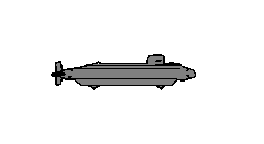
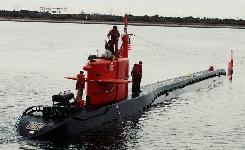
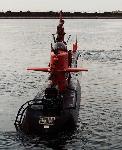
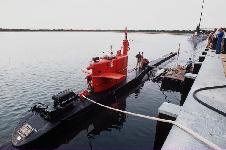
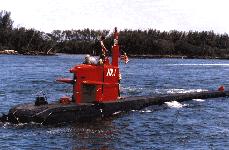
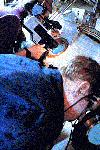
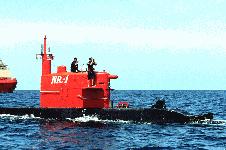
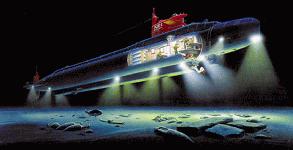



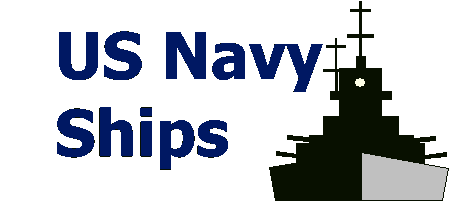
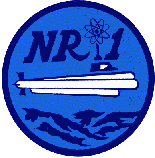 Naval Research Vessel (NR1), the Navy's smallest and only research submarine, performs underwater search and recovery, oceanographic research missions and installation and maintenance of underwater equipment to a depth of almost half a mile. NR-1 is a compact, nuclear powered undersea research and ocean engineering submarine capable of ocean search missions, such as locating and identifying objects or ships lost at sea, and recording of ocean topographic and geological features. NR-1 was designed for working near or on the seabed, performing sample gathering, recovery, implantation of objects on the bottom, or deep ocean repair.
NR-1, the first deep submergence vessel using nuclear power, was launched at Groton on Jan. 25, 1969, and successfully completed her initial sea trials August 19, 1969. Homeported at Naval Submarine Base New London CT, NR1 is unique. With a a top speed of 4 to 6 knots on the surface and never strays far from its support ship. It maneuvers by four ducted thrusters, two in the front
and two in the rear. The vehicle also has planes mounted on the sail, and a conventional rudder. The NR1 runs on a nuclear-powered steam-driven turbo-generator.
Its nuclear propulsion provides independence from surface support ships and essentially unlimited endurance. NR-1 is generally towed to and from remote mission locations by an accompanying surface tender, which is also capable of conducting research in conjunction with the submarine. NR1 operates and explores at depths greater than 2,300 feet. NR-1 can travel submerged at approximately four knots for long periods, limited only by its supplies. It can study and map the ocean bottom, including temperature, currents, and other information for military, commercial, and scientific uses.
Naval Research Vessel (NR1), the Navy's smallest and only research submarine, performs underwater search and recovery, oceanographic research missions and installation and maintenance of underwater equipment to a depth of almost half a mile. NR-1 is a compact, nuclear powered undersea research and ocean engineering submarine capable of ocean search missions, such as locating and identifying objects or ships lost at sea, and recording of ocean topographic and geological features. NR-1 was designed for working near or on the seabed, performing sample gathering, recovery, implantation of objects on the bottom, or deep ocean repair.
NR-1, the first deep submergence vessel using nuclear power, was launched at Groton on Jan. 25, 1969, and successfully completed her initial sea trials August 19, 1969. Homeported at Naval Submarine Base New London CT, NR1 is unique. With a a top speed of 4 to 6 knots on the surface and never strays far from its support ship. It maneuvers by four ducted thrusters, two in the front
and two in the rear. The vehicle also has planes mounted on the sail, and a conventional rudder. The NR1 runs on a nuclear-powered steam-driven turbo-generator.
Its nuclear propulsion provides independence from surface support ships and essentially unlimited endurance. NR-1 is generally towed to and from remote mission locations by an accompanying surface tender, which is also capable of conducting research in conjunction with the submarine. NR1 operates and explores at depths greater than 2,300 feet. NR-1 can travel submerged at approximately four knots for long periods, limited only by its supplies. It can study and map the ocean bottom, including temperature, currents, and other information for military, commercial, and scientific uses.
Its features include three viewing ports, exterior lighting and television and still cameras for color photographic studies. The keys to its underwater research capability are three 4-inch view-ports on its bottom with nineteen 250-watt gas discharge lights, eight 1000-watt and two 500-watt incandescent lights. It also sports 16 different low light TV cameras in various locations. Surface vision is provided through the use of a television periscope permanently installed on a mast in her sail area.
NR-1 has sophisticated electronics and computers that aid in navigation, communications, and object location and identification. It can maneuver or hold a steady position on or close to the seabed or underwater ridges, detect and identify objects at a considerable distance, and lift objects off the ocean floor. The submarine has no radar for surface navigation, but does have a very sensitive sonar system. Picking up objects from the ocean floor is an NR1 specialty. With a hydraulically-powered manipulator arm attached to its' bow it can pick up objects weighing up to a ton. The manipulator can be fitted with various gripping and cutting tools and a work basket that can be used in conjunction with the manipulator to deposit or recover items in the sea. Two retractable rubber-tired extendible bottoming wheels provide a fixed distance between the keel and the seabed, so the manipulator can be used.
Because it can remain on the sea floor without resurfacing frequently, NR-1 was a major tool for searching deep waters. NR-1 remained submerged and on station even when heavy weather and rough seas hit the area and forced all other search and recovery ships into port. NR-1's unique capability to remain at one site and completely map or search an area with a high degree of accuracy has been a valuable asset on several occasions. Following the loss of the Space Shuttle Challenger in 1986, the NR-1 was used to search for, identify, and recover critical parts of the Challenger craft. NR-1 conducted many underwater searches, underwater repair and salvage operations, including the recovery of critical wreckage from an Air Force F-14 lost off the coast of North Carolina. As part of a recent survey of Norwegian fjords and harbors, NR-1 discovered the USS O-12 (SS-73), renamed "NAUTILUS", and 25 other shipwrecks in a 12-hour period. The ship routinely supports requests for service from both military and scientific customers.Specifications | |
| Length overall | 145 ft 9-7/16 in. (44.4 m) |
| Pressure hull length | 96 ft 1 in. (29.3 m) |
| Diameter | 12 ft 6 in. (3.8 m) |
| Maximum beam (at stern stabilizers) | 15 ft 10 in (4.8 m) |
| Maximum navigational draft | 15 ft 1 in. (4.6 m) |
| BOX keel depth (below base-line) | 4 ft O in. (1.2 m) |
| Power Plant | One nuclear reactor one turbo-alternator Two motors (external) two propellers Four ducted thrusters (two horizontal, two vertical) |
| Design operating depth | 2375 ft (725 m) |
| Displacement submerged | 366 long tons, 409.92 short tons |
| Speed, surfaced/submerged | 4.5/3.5 knots |
| Mean Draft | 15 ft 3/4 in. (4.6 m) |
| Crew | 2 officer, 3 enlisted, 2 scientists |
| Endurance | 210 man-days (nominal) 330 man-days (maximum) |
Ships | ||||||
| Name | Number | Builder | Homeport | Ordered | Commissioned | Decommissioned |
| NR-1 | NR-1 | Electric Boat | ||||







